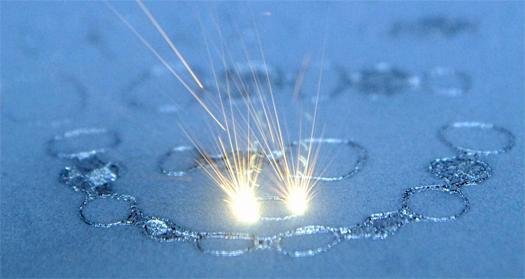Powder Bed Fusion (PBF) is the additive manufacturing (3D printing) process that creates parts by partially melting powder.
 (3DPrint.com)
(3DPrint.com)
Powder bed fusion was one of the first developed processes developed, so there are many processes that have forked off of PBF printing. Laser sintering (SLS) and direct metal laser sintering (DMLS) are simply more detailed ways of expressing the basic method of melting powder. More specifically, the powder is melted to produce a pattern. It is by building up these patterns of fused powder in layers that the PBF printer creates the part.
To melt/sinter the powder, you need a power source. Lasers are often used, but electron beams and other thermal sources can be used with more complications. The need for a pressure vacuum and care for electrical charge tends to make electron beams more expensive and finicky than lasers.
You have a tradeoff that is already apparent from heating the powder. You can either fully melt the powder together, or you can sinter the powder at high temperatures. Sintering is not the same as melting, though the material powder particles do fuse together. Sintering allows the powder particles to join together under heat and pressure. Learn more: Wikipedia: Sintering
Sintering can be accomplished through other means as well. In LPS (liquid phase sintering), binder powder is added to the main material powder, so that the binder melts and holds the main material particles together. Chemical reactions can also induce sintering.
If you melt the particles, the part usually has better properties since the particles have fused together thoroughly. However, this requires more time and much more laser energy. It is often unnecessary because sintering offers decent adhesion between particles.
Since the particles need to fuse together at a higher temperature, preheating of the powder is often used. This gives you better particle fusion, but can partially fuse unused powder. The unused powder is expensive, and is often recycled, so preheating reduces reuse.
Once the powder has fused together on one layer, the next layer must be prepared. PBF printers need some kind of process to coat the old layer with a flat layer of powder. This can be done with a blade that scrapes powder across the surface. This needs to be carefully controlled. For good accuracy, the layer of fresh powder needs to be very flat and have the same thickness. Too much thickness and the particles at the bottom of the layer don't melt. Too little and the pattern underneath can get partially melted and messed up.